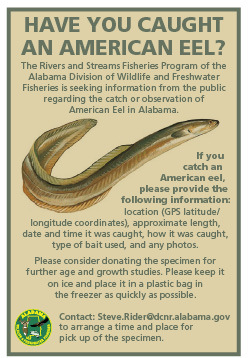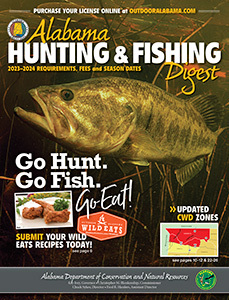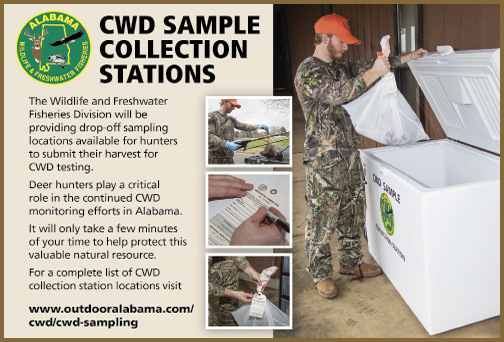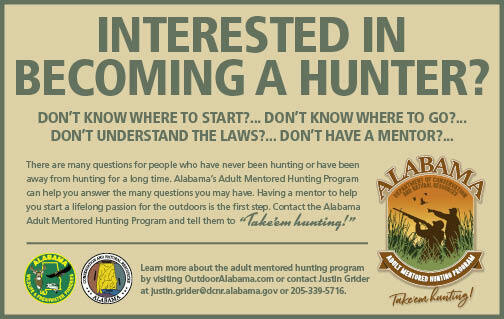You are viewing 2023's Wildlife & Freshwater Fisheries District Offices. Click to here to view information for 2022
Wildlife & Freshwater Fisheries District Offices
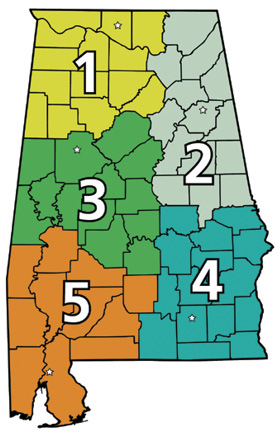
District 1
Blount, Colbert, Cullman, Fayette, Franklin, Lamar, Lauderdale, Lawrence, Limestone, Madison, Marion, Morgan, Walker, Winston
21453 Harris Station Rd.
Tanner, AL 35671
(256) 353-2634
email: [email protected]
District 2
Calhoun, Chambers, Cherokee, Clay, Cleburne, Coosa, DeKalb, Etowah, Jackson, Marshall, Randolph, St. Clair, Talladega, Tallapoosa
4101 Hwy. 21 North
Jacksonville, AL 36265
(256) 435-5422
email: [email protected]
District 3
Autauga, Bibb, Chilton, Dallas, Greene, Hale, Jefferson, Lowndes, Perry, Pickens, Shelby, Sumter, Tuscaloosa
8211 McFarland Blvd.
Northport, AL 35476
(205) 339-5716
email: [email protected]
District 4
Barbour, Bullock, Coffee, Covington, Crenshaw, Dale, Elmore, Geneva, Henry, Houston, Lee, Macon, Montgomery, Pike, Russell
3520 Plaza Dr.
Enterprise, AL 36330
(334) 347-9467
email: [email protected]
District 5
Baldwin, Butler, Choctaw, Clarke, Conecuh, Escambia, Marengo, Mobile, Monroe, Washington, Wilcox
30571 Five Rivers Blvd.
Spanish Fort, AL 36527
(251) 626-5153
email: [email protected]
Office of the Governor State Capitol
Montgomery, Alabama 36130
(334) 242-7100
fax: (334) 242-0937
Kay Ivey, Governor
Christopher M. Blankenship,
Commissioner
Chuck Sykes,
Director
Fred R. Harders,
Assistant Director
Additional Offices & Phone Numbers
To Report Violations (800) 272-4263
Enforcement
(334) 242-3467
Fisheries
(334) 242-3471
Wildlife
(334) 242-3469
Administration
64 N. Union St., Suite 567
P.O. Box 301456
Montgomery, AL 36130
(334) 242-3465
License Information
(334) 242-3829
(888)-879-4150
Alea Marine Trooper Division
(800) 272-7930
Marine Resources Division
(251) 968-7576
Hunter Orange Requirement For Hunting
During dates and in areas open by regulation to gun deer season, including youth deer season and muzzleloader deer season, all persons hunting any wildlife species, except foxes, raccoons, and opossums during legal nighttime hours or turkey or migratory birds (including crows), are required to wear an outer garment above the waist with a minimum of 144 square inches of hunter orange or either a full size hunter orange hat or cap.
Hunters are not required to wear hunter orange when:
- hunting from a stand elevated twelve (12) feet or more from the ground
- hunting in an enclosed box stand
- traveling in an enclosed vehicle
- traveling on foot no more than twenty (20) feet directly between an operating enclosed vehicle and a stand where the hunter is exempt from the hunter orange requirement. The hunter orange must be worn when traveling on foot between an operating enclosed vehicle and exempt stand when the distance is more than a direct distance of twenty (20) feet.
A small logo and/or printing is permitted on the front of hunter orange caps; otherwise, hunter orange must be of solid color and visible from any angle. Only hunter orange, commonly called blaze orange, ten-mile cloth, etc., is legal. The various shades of red as well as camo orange are not legal.
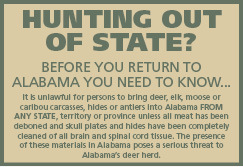
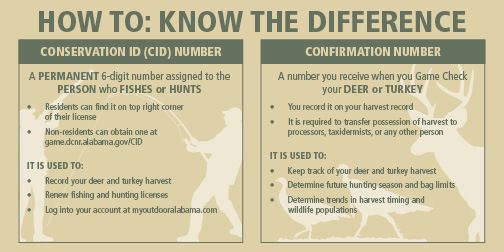
Duplicate Hunter Education Card
Do you need a duplicate Hunter Education Card?
You can now obtain a duplicate Hunter Education Card online. Go to www.outdooralabama.com and click on the hunting/hunter education link to print a duplicate Hunter Education Card.
Please call the Hunter Education Office at (800) 245-2740 if you have questions, or if you are unable to print a temporary card.
Purple Paint Protects Property
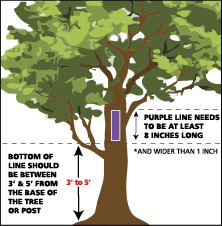
During the 2016 Legislative Session, Alabama lawmakers adopted a rule allowing landowners to paint purple stripes on trees or fence posts as an alternative to no-trespassing signs. Properly posted no-trespassing signs remain lawful.
Purple paint’s advantages include low cost, high visibility and difficult to remove. Alabama is one of several states recognizing purple paint as a valid no-trespassing marker.
According to the Code of Alabama, vertical stripes of purple paint must be longer than 8 inches, wider than 1 inch, 3–5 feet from the ground, readily visible to people approaching the property, 100 feet or less apart on forestland and less than 1,000 feet on non-forestland.
